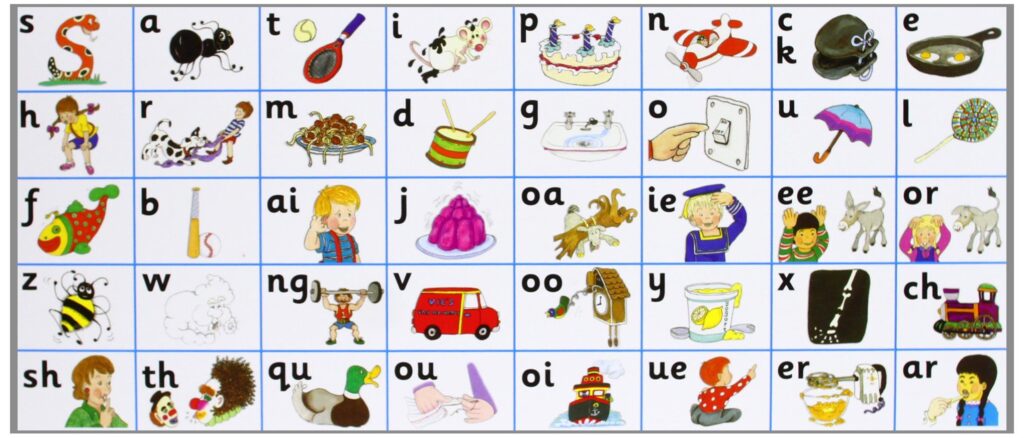“Phonics song”… It’s the word that I used to hear a lot, especially when my daughter was young as she loved watching the rhymes and songs videos on YouTube. The phonics song was one of her favorites. We used to enjoy that song together and sing along. It was such a treat. A a a for apple, B b b for ball… it was so immersive that I learned the entire song with her.
I truly realized the importance of phonics when my kid started preschool. Whenever her teacher asks something related to phonics, she’s the first one to answer. When she’s doing her homework, she already knows all the answers. It makes me very happy and proud of her. It shows that our daily habit of watching phonics videos together paid off.
After she went to kindergarten-1, I began to take more interest in how Phonics is being taught in the school. In this blog, we will share the same strategy with you to teach phonics to your little ones effectively.
Let’s begin with Jolly Phonics.
What is Jolly Phonics?
Jolly Phonics – I heard about it the very first time when my daughter got admission in kindergarten-1. Her teacher told me that they would practice Jolly Phonics in the kindergarten section regularly, and the kids will follow that. So, when we came home, I googled Jolly Phonics and saw YouTube videos to learn more about it.
Jolly Phonics is a fun and child-centered approach to learning alphabet sound. It teaches the phonics sound of 42- letters by forming a group of letters. Each one of them has a different stage which is called group. So, ultimately, with each passing step, a child learns phonic sounds and moves one step further towards learning literacy.
Jolly phonics is used extensively in the UK curriculum. Therefore, you can find this method of teaching phonics to the kindergarten in almost all schools with the British curriculum.
Which Mechanism Does Jolly Phonics Works On?
Jolly Phonics uses multi-sensory and synthetic phonics methods to teach letter sounds to children. In this method, alphabet sound is being taught with the corresponding letters. Using this technique, kids can easily identify the letters by their sounds.
You can use different sensory methods to teach letter sounds to your little one. Once your child knows the letter sounds, they will understand the blending and segmenting of the letters. So, when you ask them to read a word, they can identify the letters, and blend the sounds to pronounce the word.
Similarly, when you ask them to write a word, they will pronounce the word by recognizing letter sounds, form a word, and write it down.
Here’s a unique synthetic approach of phonics to help your child master the skills of identifying letter sounds, forming words using letter sounds, blending and segmenting the words.
Check out the Jolly Phonics song from Aa to Zz.
Phase-wise/ Group-wise Distribution
A 42-letter sound chart contains a single sound of alphabets and digraphs (2 letters one sound). It will help your kid learn the base sounds of letters and digraphs, which will make it easy for them to blend the words using the sounds.
Each letter is introduced with some fun action or activity to help children learn and memorize the concepts without any hassle. Kids learn things they perceive more quickly than the stuff taught to them. Therefore, introducing letter sounds to the children using multi-sensory techniques is a great choice.
For example, phase one begins with s a t i p n. Since the sounds are very easy to learn and practice and these letters can be used to form all the basic words in the very first place (at, sat, pin, tin, tap, pan, etc.)
Similarly, there are different phases in Jolly phonics which help kids to get a better understanding of letters, their sounds, and how they are combined to form different words.
Tricky Words
Children are also been taught the tricky words (these are the words with indefinite sound patterns and cannot be blended). Tricky words are taught separately along with phonic sounds since they help children to pick up the common words that can be used to build up a proper sentence.
Examples: I, am, he, she, it, is, they, all, you, your, etc.
Final words
Learning Phonics isn’t as difficult as you might think. In fact, it has become much easier since kids can watch cartoons or phonics songs on YouTube. Also, there are many books and worksheets available online that come with phonics along with the pictures
If you’re a mom and planning to homeschool your kids, then Jolly Phonics is the best way to get started. In our upcoming blogs, we’ll discuss different phases so you can get an accurate picture of how they work. teaching phonics to your kids
We’ll be uploading more worksheets and tutorials soon. So, stay tuned and keep visiting MommyTutors.




